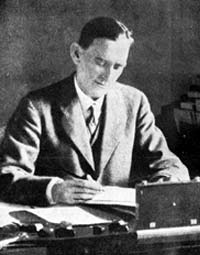John Marshall (archaeologist) facts for kids
Quick facts for kids
Sir charles
John Marshall
|
|
|---|---|
 |
|
| Born | 19 March 1876 Chester, England
|
| Died | 17 August 1958 (aged 82) |
| Alma mater | King's College, Cambridge |
| Known for | Excavations in Harappa, Mohenjodaro, Sanchi, Sarnath, Taxila, Crete and Knossos |
| Awards | CIE Knighthood FBA |
| Scientific career | |
| Fields | History, archaeology |
| Institutions | Archaeological Survey of India |
| Influences | James Prinsep, H. H. Wilson, John Leyden, Henry Thomas Colebrooke, Colin Mackenzie and William Jones |
Sir John Hubert Marshall (born March 19, 1876, died August 17, 1958) was a famous English archaeologist. He led the Archaeological Survey of India for many years, from 1902 to 1928. During his time, he helped uncover two very important ancient cities: Harappa and Mohenjo Daro. These cities were part of the amazing Indus Valley Civilisation.
Contents
Who Was Sir John Marshall?
Becoming an Archaeologist
John Marshall went to school at Dulwich College. Later, he studied at King's College, Cambridge. In 1898, he won a special award called the Porson Prize.
He then learned about archaeology by working at a place called Knossos. This was in Crete, an island in Greece. He worked with Sir Arthur Evans, who was finding out about the ancient Minoan civilization. This civilization was from the Bronze Age.
Leading Archaeology in India
In 1902, a new leader in India, Lord Curzon, chose Marshall for a big job. Marshall became the Director-General of Archaeology for the British government in India.
Marshall changed how archaeology was done in India. He started programs to list and protect old buildings and artifacts. He also made sure that Indian people could join in the excavations. Many of his students were Indian. Because of this, Marshall was seen as someone who understood and supported Indian nationalism. He agreed with Indian leaders who wanted more self-rule or even independence for India. Many Indians admired him greatly.
Major Discoveries and Projects
In 1913, Marshall began digging at Taxila. This work continued for 21 years! In 1918, he started the Taxila Museum. Today, this museum holds many ancient items. It also has one of the few pictures of Marshall.
He then worked at other important sites. These included the Buddhist centers of Sanchi and Sarnath.
Uncovering Ancient Civilizations
Marshall's work showed how old Indian civilization truly was. He found important evidence about the Indus Valley civilization. He also learned more about the Mauryan age, which was the time of Emperor Ashoka.
In 1920, Marshall started a dig at Harappa. Daya Ram Sahni was the director of this dig. The city of Mohenjo-Daro was found by R. D. Banerji in 1921. Work began there in 1922.
The discoveries at these sites were amazing. They showed an ancient culture with its own writing system. News of these findings was shared in the Illustrated London News on September 20, 1924. Experts connected these items to the ancient civilization of Sumer in Mesopotamia.
Later digs showed that Harappa and Mohenjo-Daro were very advanced. They were planned cities with plumbing and public baths.
A Challenge in Excavation
However, Marshall made a mistake in his digging method. He dug in flat, horizontal layers. This mixed up items from different time periods. Because of this, valuable information about where things were found was lost.
Later, another archaeologist named R.E.M. Wheeler fixed this problem. Wheeler understood that it was important to follow the natural layers of the earth. This way, items from different times would not get mixed up. Wheeler also brought a very careful, almost military-like way of working to archaeology.
Marshall also led digs at a prehistoric mound called Sohr Damb. This was near Nal in Baluchistan. Some pottery from this site is now in the British Museum.
Later Life and Honors
Retirement and Death
Marshall retired from his job in 1934. He then left India. He passed away on August 17, 1958, at his home in Guildford, England.
Awards and Recognition
Marshall received several honors for his work.
- In June 1910, he was made a Companion of the Order of the Indian Empire (CIE).
- In January 1914, he received a knighthood, which meant he could use "Sir" before his name.
- In 1921, Calcutta University gave him an honorary Doctor of Philosophy degree.
- In 1936, he was chosen as a Fellow of the British Academy.
See also
 In Spanish: John Marshall (arqueólogo) para niños
In Spanish: John Marshall (arqueólogo) para niños

